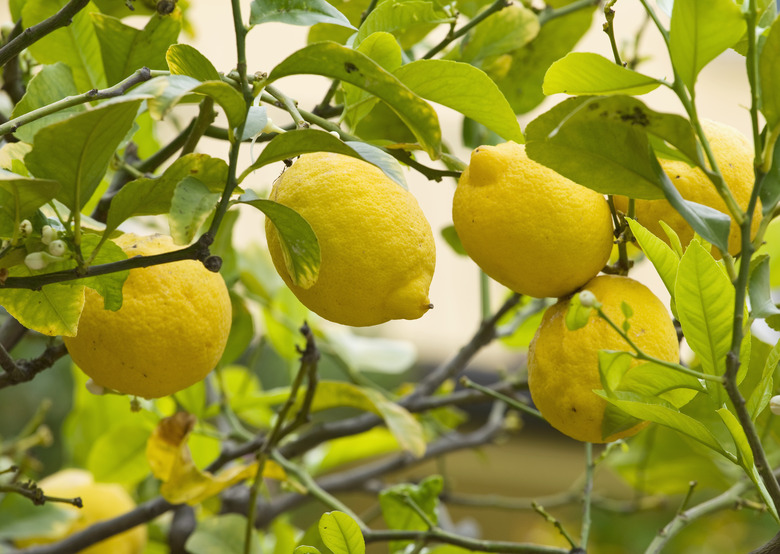How To Grow Lemon Trees In Texas
Don't buy lemons in the grocery store when you can raise them in your South Texas backyard. Not only do lemon trees (Citrus x limon, USDA hardiness zones 9-11) produce a bounty of sour fruit, but their glossy foliage also provides ornamental benefits to the landscape.
In Texas, the best time to start planting lemon trees is at the end of winter, typically in February. Keep in mind that lemons are extremely cold-sensitive, and the Texas A&M AgriLife Extension recommends growing lemon trees only within the Lower Rio Grande Valley. Popular lemon cultivars grown in Texas include Eureka, Lisbon and Avon.
If you live in Texas outside this area, you may have success growing lemon trees in pots that you can move indoors during winter. Lemon tree care indoors includes keeping the soil slightly moist, withholding fertilizer during the winter, and placing potted trees in a sunroom or other location that receives as much sun as possible during the day. Lemon tree care in pots is easier if you grow a dwarf cultivar that's suited to container culture.
Things Needed
- Lemon tree sapling
- Spade
- Aluminum foil
- Citrus fertilizer
- Systemic herbicide
1. Select a Planting Site
Choose a gardening site that shields the lemon tree against cold winds. For the best protection, choose a site in full sun and on the south end of a home or structure Lemon trees are not finicky about the soil as long as it drains well.
2. Choose a Lemon Sapling
Select a lemon tree sapling, usually sold in Texan nurseries potted in a soilless potting mix. This is the most common method of starting a lemon tree. For best results, choose a plant 36 to 48 inches tall that has three or four side branches. County Cooperative Extension Services offer advice for where to buy lemon trees in Texas.
3. Dig the Planting Hole
Dig a hole twice the diameter of the sapling's current container and 1 to 2 inches shorter than the container's height.
4. Prepare the Tree for Planting
Remove the lemon tree from its container. Shoot a gentle stream of water onto the tree's root ball to rinse away a couple inches of soil mixture from the exterior of the root ball, revealing the tree's bare roots.
5. Plant the Lemon Tree
Place the sapling in the hole. Fill the hole halfway to the top with the soil originally removed to dig the hole. Water the added soil to help it settle, then add the rest of the soil to fill in the hole.
6. Build a Water Reservoir
Make a raised soil ring around the sapling to build a water reservoir that prevents runoff and allows the water to seep into the soil around the tree's root system. The ring should be approximately 24 inches in diameter and 2 to 3 inches high around the outside of the circle.
7. Keep the Lemon Tree Watered
Water the lemon tree. Fill the soil ring with water and let the water absorb into the soil. Repeat every two to three days. Two weeks after planting the lemon tree, reduce watering to once every 10 days. Once the soil ring has disintegrated, the lemon tree will be established and will only need water every two weeks.
8. Apply Fertilizer Three Times Yearly
You won't need to fertilize the lemon tree the year you plant it. In subsequent years, make three fertilizer applications, using 1/3 the recommended amount each time in February, April and August. The University of Arizona Cooperative Extension recommends using ammonium sulfate, ammonium phosphate or a fertilizer that's specifically blended for lemon trees. Apply the fertilizer immediately before a watering session so the water will help carry the nutrients in the fertilizer to the roots.
9. Protect the Base of Tree
Wrap an 8-inch-wide strip of aluminum foil around the base of the lemon tree to keep branches from sprouting at the tree's base and also to protect it from any herbicide sprays you may apply to your lawn.
10. Harvest Lemons from Your Tree
Harvest the fruit. A lemon tree will typically start producing fruit three to four years after planting. Depending on the variety, fruit may begin appearing in the spring, summer or fall. Lemons are ready for harvesting when they turn yellow.
Warning
Vegetation growing near the lemon tree will rob the surrounding soil of nutrients. Keep the area under the tree's drip line free of weeds and lawn grass using either physical removal or chemical controls such as a systemic herbicide. If using an herbicide, keep the chemicals from getting on the tree — the foil strip you applied in Step 9 will help protect it.
